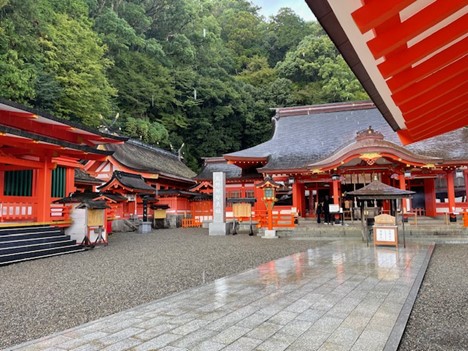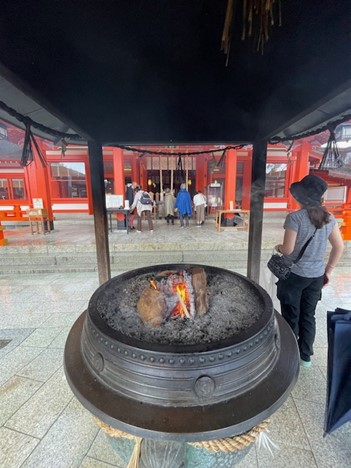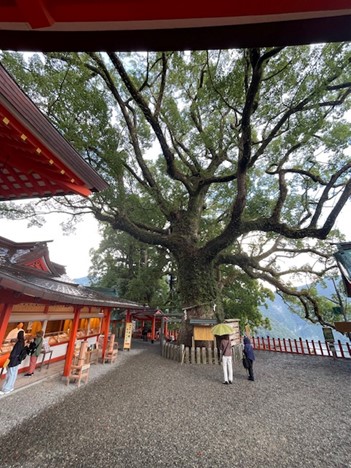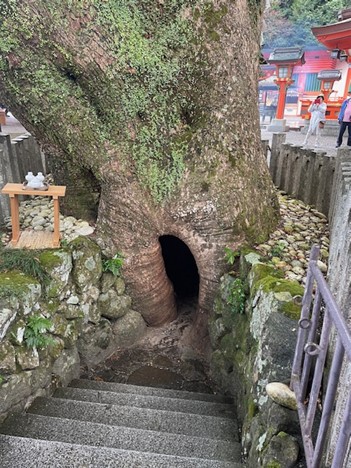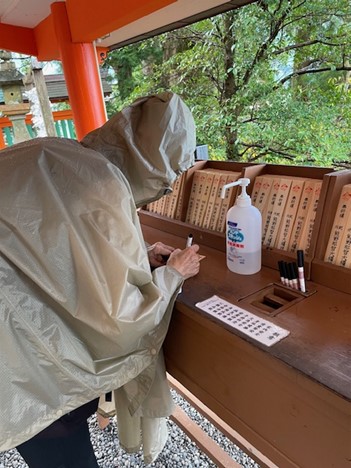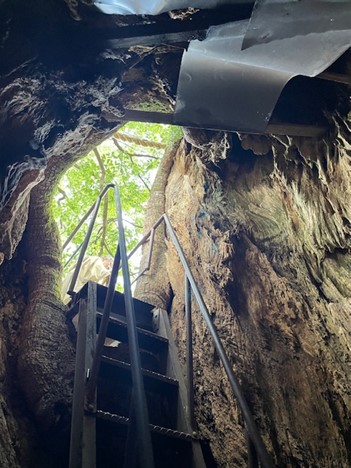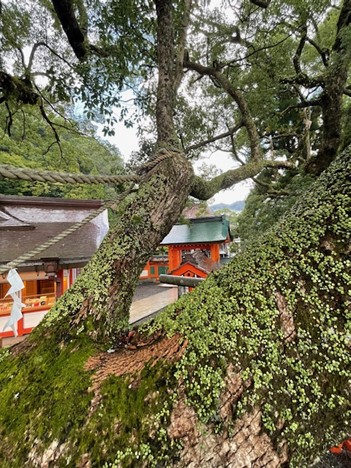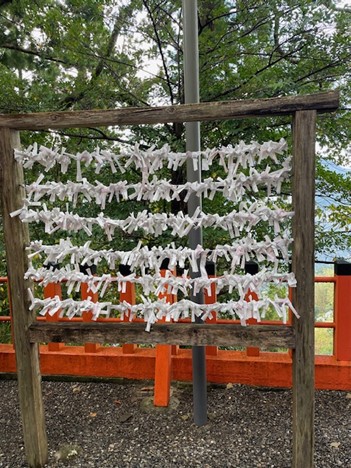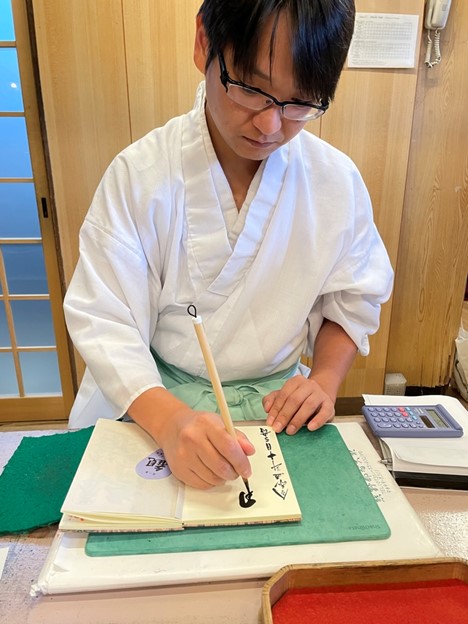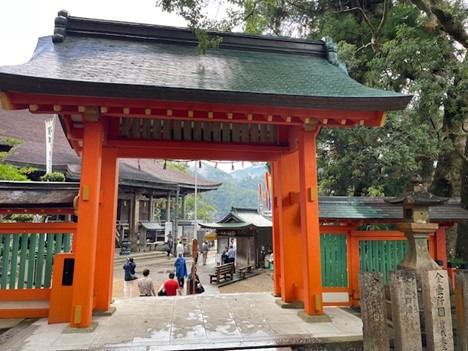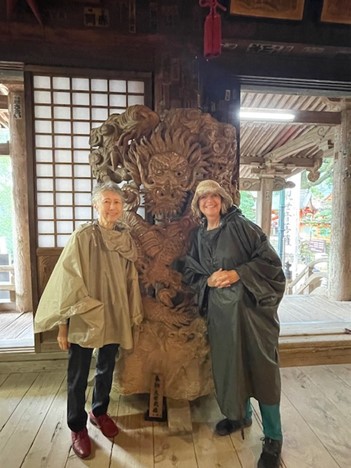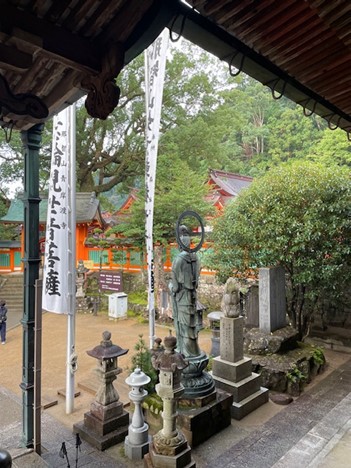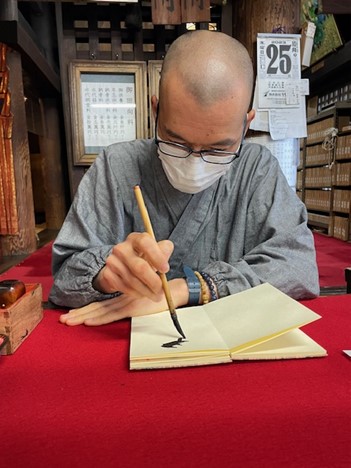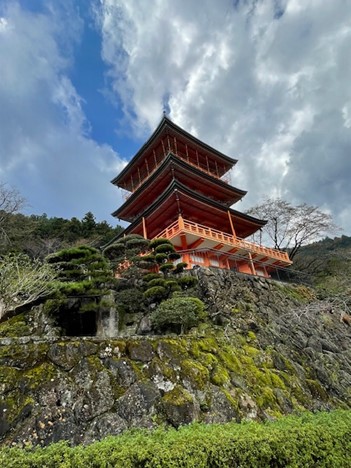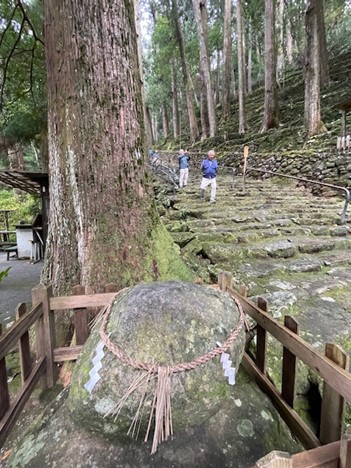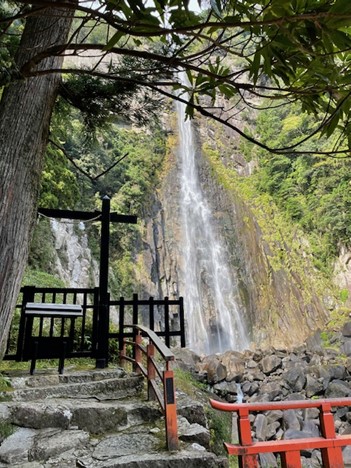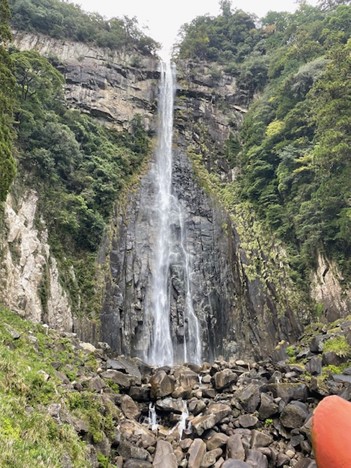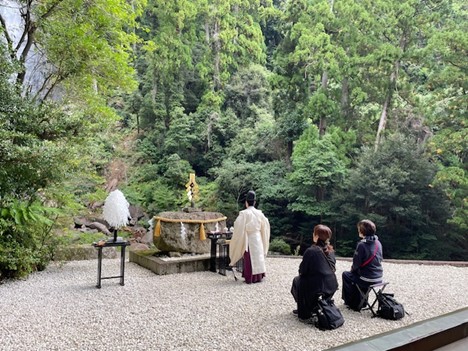After embarking on the shore of the Kumano-gawa river, it was just a short walk to the entrance of the Hayatama Taisha. I was surprised that not only the Torii was colored in bright red, but all the other buildings also – a big difference to the Hongu Taisha, where every building was of natural wood.
.
.
.
.
.
Shigeo and I in front of the Torii
.
.
.
.
.
Hardly any people were at the Jinja when we arrived. It is believed that a matchmaking deity is dwelling here and people come to pray for a good partner.
.
.
.
.
.
800 year old tree planted by a powerful feudal lord when the shrine was reconstructed.
.
.
.
.
A beautiful little building
After getting our stamp at the Grand shrine, we soon left for an interesting site – the Kamikura-jinja. We first walked through a very poor neighborhood (reminding me of some sites I saw on my Shikoku pilgrimage eight years ago) to the foot of Mt. Gongen (Reincarnation).
.
.
.
.
.
.
.
.
I was not sure if people still live in these houses.
.
.
.
.
.
538 steep, uneven stone stairs lead up to the Kamikura-jinja. Every step needed utmost concentration. The path led us up to a place where the Kumano deities are believed to have descended from the sacred, heavenly country (Takama-ga-hara, High Plain) down to the human world.
.
.
.
.
.
Behind the jinja you can see a huge, powerful rock known as Gotobiki-iwa. It is believed that the three deities from the Kumano Grand shrines first descended on the large rock and the shrine beside it is the dwelling place of a deity. The view down to Shingu City and the Pacific Ocean is spectacular.
After bringing Hiroko-san to the train the next day, we continued our trip to the Kumano Nachi Taisha. It was rainy when we walked up the stairs, passing centuries old cedar trees.
.
.
.
.
.
The Nachi Taisha is built on the side of a mountain at 350m sea level.
.
.
.
.
.
After cleansing hands and mouth, we continued to an area consisting of many bright, red colored wooden buildings.
.
.
.
.
.
Many tourists and pilgrims visit this shrine. The area of the Nachi Taisha shrine is huge and covers several levels and areas with buildings. Nachi Taisha is the head shrine of more than 4000 Kumano shrines all over Japan and not everything is accessible for pilgrims. The shrine you see in the photo is open for pilgrims.
.
.
.
.
Another beautiful roofline
.
.
.
.
.
We were lighting incense in this enormous holder, the first incense cauldron I saw at a Jinja.
.
.
.
.
.
I was especially intrigued by this enormous 800-year-old Camphor tree standing beside a hall where all kinds of luck symbols and souvenirs are sold. The tree is hollow and one can climb through the hollow area to the other side. By doing this, one is re-born through the womb of nature. Tree worship is very common in Shinto. It is believed that it is a special abode to the kami (deity).
.
.
.
.
Stairs down to the entrance of the tree
.
.
.
.
.
Pilgrims can write a prayer or a wish on one of these wooden tablets, carry the stick through the inside of the tree and place it on a rack on the other side. All the donated sticks will be burned by the priests.
.
.
.
.
.
The exit of the tree-womb
.
.
.
.
View down from the tree
The rope to the left with the white zig-zag paper indicates the sacredness of the area.
.
.
.
.
.
It is also possible to ask the oracle what the future will bring. It is written on a piece of paper. After reading it, people attach the paper on this construction.
.
..
.
.
.
In every temple or shrine, I presented my pilgrim’s book (I bought it in Koyasan eight years ago) and a specific calligraphy with date and stamp was gracefully written on a page. I always loved to observe their careful writing with the brush.
.
.
.
.
.
This gate leads to the Seiganto-ji temple built in the 16h century. Buddhism was introduced to Japan in the 5th and 6th century. After some time, the kamis were seen as manifestations of Buddhas. The sun goddess Amaterasu, for example, was considered by Shingon Buddhism as the embodiment of the Cosmic Buddha. Many temples were built beside shrines and existed peacefully together for over a 1000 years. This changed dramatically with the Meiji Restoration in 1868. The effort to return to “pure” Shinto was not very successful – as seen in Nachi Taisha.
.
.
.
.
.
The temple stands on wooden poles and has a large, inside area. Yuko and I are posing in front of a powerful dragon. The temple is dedicated to Kannon (Bodhisattva of Mercy, lit. Sound-observing or Observation-divinity Bodhisattva) and is the first temple of a 33 temple pilgrimage dedicated to Kannon.
.
.
.
.
View from the temple to the shrine with the statue of Kannon
.
.
.
.
.
I got another calligraphy in my pilgrimage book, written by a Buddhist monk.
The oldest place of worship in this area is the 133m high waterfall, the highest waterfall in Japan. When we walked down, we passed a picturesque three story pagoda.
.
.
.
.
Three story pagoda
.
.
.
.
.
Despite being prepared for many visitors, the path to the waterfall kept its charm.
.
.
.
.
.
The Nachi-no-Otaki has been worshipped as a deity called Hiro Gongen since ancient times. The beauty of nature is thought to lead the mind of a human being to the higher and deeper world of the divine, the world of the kami. The most beautiful spots in Japan are generally the sites of shrines.
.
.
.
.
.
The waterfall is used by the Yamabushi (Shugendo religion) as a place of ascetic training. It is one of 48 waterfalls where they practice body-mind endurance and try to achieve enlightenment.
.
.
.
.
.
We witnessed a Shinto ritual in front of the waterfall. To the left of the priest is a wand with a lot of white paper streamers. This wand is used for purification and moved in a special way to purify the believers. The rites are done to ward off misfortune and secure the cooperation with a kami. Rituals in the Shinto tradition are important, the worship always includes all the senses.
.
.
.











